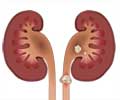Incisional Hernias - Laparoscopic Surgical Repair
Laparoscopic Surgery is used to treat Reducible Incisional hernias. The more complicated hernias may require direct visualization to plan the surgery.
Steps of Surgery
This procedure is performed under General Anesthesia.
- After administering anesthesia the abdomen and groin are prepared with an antibacterial solution.
- The abdomen is inflated with a harmless gas (carbon dioxide) to allow the doctor to view the internal structures.
- Three to four small keyhole incisions are used for an incisional hernia repair: two are 5 mm in length and one or two maybe 12 mm in length.
- A laparoscope is a thin, telescope-like instrument, which helps to visualize the operating field, if inserted.
- A camera, which is attached to the laparoscope, captures and produces a continuous image that is magnified and projected onto a television screen.
- Using the laparoscopic surgical tools, the tissues and vessels are divided until the weakness in the abdominal wall is identified.
- The tissue around the defect is dissected to find good, strong, healthy tissue, known as fascia. The fascia is the gristly layer that provides the strength to the abdominal wall.
- The defect is then closed, either by suturing together the good strong tissue on either side of the hole or by applying a synthetic mesh across it to patch the hole.
- The small abdominal incisions are closed with stitches or with surgical tape. The small abdominal incisions heal faster and within a few months, the incision is barely visible.
Benefits of laparoscopic hernia surgery:
- Three to four tiny scars rather than one larger incision
- Reduced postoperative pain
- Faster return to work
- Shorter recovery time and earlier resumption of daily activities (a recovery time of days instead of weeks)















i am 54 years lady at present i have an incisional Hernia, 4 years back i had undergone operation uterus removing whether immediate surgery is required but i don't have any pain